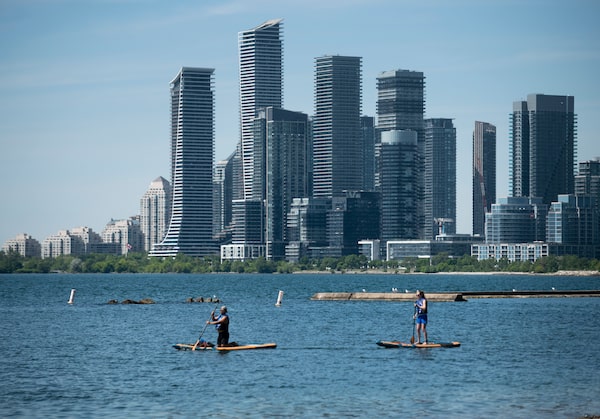The beach at Montreal's Old Port on July 6, 2012.Paul Chiasson/The Canadian Press
On a soft, hazy late summer evening this week, Calgarians flocked outdoors to take advantage of what could be one of the last warm-weather weekends of the season. Many of them headed down to the river.
Calgary stands on the Bow, which begins life up in the mountains and winds its way through the foothills and prairie. It’s a beautiful waterway, wide, winding, fast in some parts, slow in others. For decades, Calgary turned its back on this, its outstanding natural feature. In the 1960s, it even considered allowing a rail line and expressway to be built along the riverbank. Thanks to a citizens campaign led by Jack Leslie, an alderman and later mayor, the project went down to defeat. Calgary began to embrace the Bow and its tributaries.
Today, a whole network of pathways and parks follows the river. At its core is Prince’s Island, a heavily used green space minutes from the skyscrapers of downtown that draws crowds of visitors to its flower gardens, walking paths and cross-country skiing trails.
Cyclists and pedestrians use the new walk way along the Bow River in Calgary on Oct. 3, 2021.Todd Korol/The Globe and Mail
When I visited, couples were taking in the sunset, parents were watching their kids climb trees, young people were picnicking on the grass and rafters were drifting down the river, a couple of them even making their way in a huge inflatable unicorn. It was a wonderful scene, the result of smart, people-focused city building at its best. As the city builds new flood barriers along the Bow, protecting the downtown from a calamity like the one in 2013, it is adding new public spaces, pathways and bridge ramps to make the river still easier to enjoy.
Calgary is not the only place rediscovering its waterfront. From coast to coast, Canadian cities are turning the once-ugly and polluted water’s edge into inventive urban spaces. It’s one of the best things to happen to our cities in my lifetime.
Opinion: Canada: From Toronto to Kelowna, the impossible country never fails to impress
Vancouver led the way in the 1970s by redeveloping the industrial area under the Granville Bridge. Ever since, Granville Island has been drawing throngs to its waterside market, restaurants and culture spots. It was the beginning of the revival of False Creek, the long inlet adjoining English Bay. Today you can walk all along its shore on a system of pathways
Winnipeg redeveloped the Forks, an old railway hub at the confluence of the Red and Assiniboine rivers that is now a lovely gathering place with a market, prairie garden, riverside walkway, canoe rentals and displays about the area’s pioneer and Indigenous heritage.
Montreal has the Old Port, where visitors can walk, bike, ride a Ferris wheel, take a boat tour and enjoy a floating spa. Halifax’s revived waterfront has quayside restaurants, a four-kilometre boardwalk and museums of immigration and maritime history.

Paddle boarders head east along the waters off Sunnyside Beach on Jun. 14.Fred Lum/The Globe and Mail
Toronto was late to the game. The redevelopment of federal lands at the west end of the harbour created the lively Harbourfront district but left a wall of drab condominiums that only further severed the city from its neglected waterfront. Learning their lesson, governments created Waterfront Toronto, which orchestrated the rest of the revival. It brought in top architects to create a series of ingenious public spaces like Sugar Beach, with its beach chairs and pink umbrellas, and Sherbourne Common, with its charming 240-metre channel of running water.
Yes, there are lots of condos, but they are better designed now, and having all those people living down by the water can only add to the vitality of this emerging waterside neighbourhood.

An aquabus ferry sails in front of Vancouver's skyline.Alia Youssef/The Globe and Mail
The pièce de résistance is taking shape right now at the east end of the harbour. Giant digging machines are creating a new mouth for the poor old Don River. Once a sort of running sewer and running joke at the same time, it will flow into the harbour through a string of parks that promise to be one of Toronto’s greatest assets.
It’s the start of a rebirth for the Port Lands, the vast swath of old industrial land built on what was once one of the biggest wetlands on the Great Lakes. When I was growing up we used to drive right past them, inhaling the smell of oil from the hulking oil tanks that stood there. Soon, it will draw thousands to enjoy the revived Don and gaze at the Toronto skyline from the harbourside. It has taken far too long and it is costing a fortune, but the result should be brilliant.
Calgary saw half a century ago that the water’s edge was something to cherish. Now all of Canada is building on that insight.
 Marcus Gee
Marcus Gee